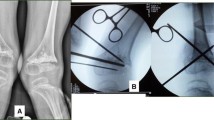Abstract
Deformation due to growth disturbance after epiphyseal fractures around the knee may involve more than the primarily injured epiphysis, as spontaneous corrective growth of the opposite epiphyseal plate can take place in an attempt to maintain overall alignment of the leg. As a result, there will be an inclination in the knee joint line if corrective osteotomy is only performed for the primary angulation. We report two cases of this complex deformity in which corrective osteotomies of both the distal femur and the proximal tibia were performed, resulting in correct alignment of the overall leg axis and knee joint axis.
Similar content being viewed by others
Author information
Authors and Affiliations
Additional information
Received: 25 May 1996 Accepted: 20 November 1996
Rights and permissions
About this article
Cite this article
Beck, A., Kundel, K. & Rüter, A. Significance of corrective growth of opposite physes in the surgical correction of deformity following epiphyseal injury around the knee joint. Knee Surgery 5, 38–41 (1997). https://doi.org/10.1007/s001670050022
Issue Date:
DOI: https://doi.org/10.1007/s001670050022




